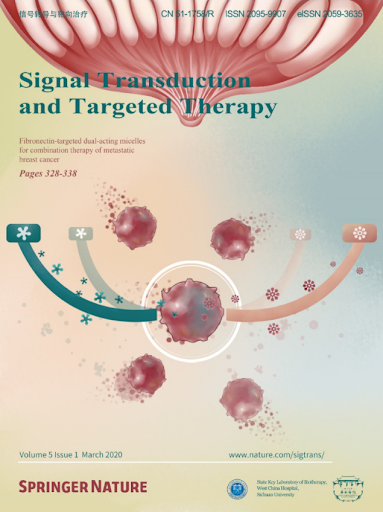硝酸钠通过唾液素介导的巨噬细胞再平衡预防代谢综合征。
IF 52.7
1区 医学
Q1 BIOCHEMISTRY & MOLECULAR BIOLOGY
引用次数: 0
摘要
代谢综合征以代谢功能障碍相关脂肪变性肝病(MASLD)和2型糖尿病(T2DM)为特征,对全世界患者的健康构成重大威胁;然而,目前还没有有效的治疗方法。在本研究中,我们发现口服硝酸钠(NaNO3)可大大减弱由胆碱缺乏的高脂肪饮食、western饮食或蛋氨酸/胆碱缺乏饮食诱导的小鼠masld样和t2dm样表型的发展和进展。NaNO3通过重新平衡CD206+/CD11C+极化(抗炎/促炎)和骨髓源性巨噬细胞(momf)的功能来减弱代谢紊乱。通过代谢紊乱动物模型和编码sialin的Slc17a5基因功能突变的骨髓重建小鼠,我们证明了NaNO3通过sialin在momf中的作用来保护代谢紊乱。NaNO3可以直接调节momf在体外和小鼠体内的极化和功能,在这种情况下,口服和肠内共生细菌产生的一氧化氮基本上被消除。在分子水平上,sialin通过抑制关键转录因子Rel,抑制组织蛋白酶L (CtsL)的表达,从而激活Nrf2通路,调节巨噬细胞稳态,改善代谢异常。有趣的是,唾液素- ctsl - nrf2通路在代谢功能障碍相关脂肪性肝炎(MASH)患者的人巨噬细胞中下调。总之,我们证明了NaNO3对代谢综合征的预防和治疗作用,并揭示了一种新的巨噬细胞再平衡策略,涉及NaNO3通过一个新的sialin通路。我们的研究表明,NaNO3可能是一种用于管理和减轻人类代谢紊乱的药物。本文章由计算机程序翻译,如有差异,请以英文原文为准。
Sodium nitrate protects against metabolic syndrome by sialin-mediated macrophage rebalance.
Metabolic syndrome, characterized by metabolic dysfunction-associated steatotic liver disease (MASLD) and type 2 diabetes mellitus (T2DM), poses a significant threat to patients' health worldwide; however, efficient treatment is currently unavailable. Here, we show that oral administration of sodium nitrate (NaNO3) greatly attenuates the development and advancement of MASLD-like and T2DM-like phenotypes in mice induced by choline-deficient high-fat, western, or methionine/choline-deficient diet. NaNO3 attenuates metabolic turbulence by rebalancing CD206+/CD11C+ polarization (anti-inflammatory/pro-inflammatory) and the function of bone marrow-derived macrophages (MoMFs). Using metabolic disorder animal models and bone marrow-reconstituted mice with mutated gene function in Slc17a5, which encodes sialin, we demonstrate that NaNO3 protects against metabolic disorders through the actions of sialin in MoMFs. NaNO3 can directly regulate MoMFs polarization and function in vitro and in mice, in which nitric oxide production from oral and enteral symbiotic bacteria is essentially abolished. At the molecular level, sialin, via the inhibition of the key transcription factor Rel, inhibits cathepsin L (CtsL) expression and thereby activates the Nrf2 pathway to modulate macrophage homeostasis and ameliorate metabolic abnormalities. Interestingly, the sialin-CtsL-Nrf2 pathway is downregulated in human macrophages from metabolic dysfunction-associated steatohepatitis (MASH) patients. Overall, we demonstrate the prophylactic and therapeutic effects of NaNO3 on metabolic syndrome and reveal a new macrophage rebalancing strategy involving NaNO3 through a novel sialin pathway. Our research indicates that NaNO3 may be a pharmaceutical agent for managing and alleviating metabolic turbulence in humans.
求助全文
通过发布文献求助,成功后即可免费获取论文全文。
去求助
来源期刊

Signal Transduction and Targeted Therapy
Biochemistry, Genetics and Molecular Biology-Genetics
CiteScore
44.50
自引率
1.50%
发文量
384
审稿时长
5 weeks
期刊介绍:
Signal Transduction and Targeted Therapy is an open access journal that focuses on timely publication of cutting-edge discoveries and advancements in basic science and clinical research related to signal transduction and targeted therapy.
Scope: The journal covers research on major human diseases, including, but not limited to:
Cancer,Cardiovascular diseases,Autoimmune diseases,Nervous system diseases.
 求助内容:
求助内容: 应助结果提醒方式:
应助结果提醒方式:


